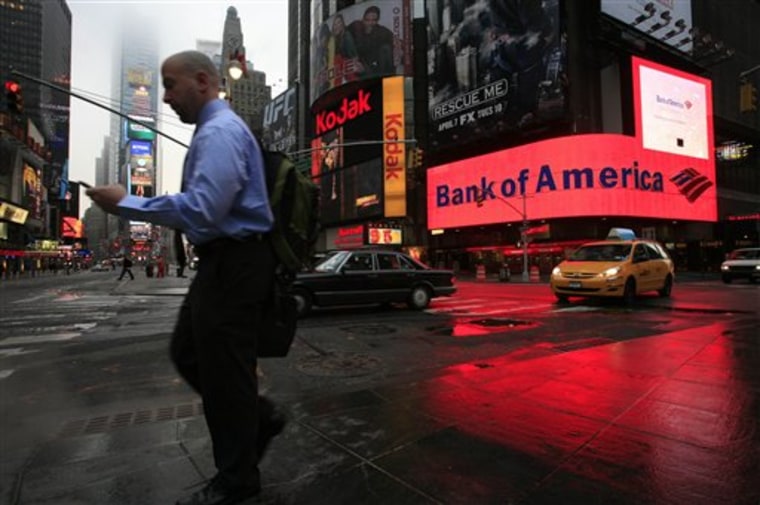Bank of America joined other major banks in reporting better-than-expected second quarter income Friday, earning $2.42 billion even as losses from failed loans continued to rise.
The results, which included $713 million of dividend payments tied to a federal bailout, compared with profits after preferred dividends of $3.22 billion in the same three-month period a year ago.
Earnings per share, which reflected a much higher amount of shares outstanding, fell to 33 cents from 72 cents. That was well ahead of the 28 cents per share forecast of analysts surveyed by Thomson Reuters.
The results also reflected a $5.3 billion pretax gain from selling part of the bank's stake in China Construction Bank Corp. and a charge to bolster a federal deposit insurance fund.
Separately on Friday, Citigroup Inc. reported that it earned $3 billion after preferred dividends, or 49 cents per share. Analysts had predicted the New York-based bank would post a loss.
BofA's CEO Ken Lewis said in a statement that continued weakness in the economy, rising unemployment and deteriorating credit quality would affect the company for the rest of this year and next. That echoed views from JPMorgan Chase & Co. executives, who also reported continuing loan problems Thursday even as their company posted strong second-quarter earnings.
Despite higher earnings, Bank of America's shares fell 32 cents, or 2.5 percent, to $12.85 in midday trading Friday.
"The numbers were good," said Tony Plath, finance professor at the University of North Carolina at Charlotte. "But big consumer banks, and Bank of America is the biggest, they are the ones who have the most to lose in a prolonged consumer-oriented recession."
The Charlotte, N.C.-based bank has about 55 million consumer and small business customers, making it vulnerable to delinquencies and defaults, yet also ready to thrive when the economy recovers.
Bank of America, like Goldman Sachs Group Inc. and JPMorgan Chase, said it had a handsome profit from its trading business. The company acquired Merrill Lynch & Co. early this year, helping to boost revenues by 61 percent compared with a year ago to $32.77 billion.
Profits in BofA's global markets unit jumped by $1.1 billion to $1.38 billion. Its global wealth and investment management division saw net income fall 24 percent to $441 million.
But, like JPMorgan, BofA did report continuing losses from failed loans. Bank of America said it recorded a $13.4 billion provision for loan losses during the second quarter as consumers struggled with debt amid rising unemployment, compared with $5.8 billion a year ago.
Troubled loans, or nonperforming assets, increased to $31 billion from $9.75 billion a year ago. The bank also lost $1.6 billion on card services, after posting a profit a year ago.
The company also said its mortgage revenue rose following its acquisition of lender Countrywide Financial Corp., reflecting the refinancing boom triggered by lower mortgage rates.
On a call with analysts, Lewis said the bank's outlook for the economy is close to the consensus view with unemployment peaking somewhere around 10 percent. He also said the bank anticipates bankruptcy filings for individuals to continue to increase, and home prices to fall further.
"These are the assumptions we use to run the company," Lewis said. "Based on this scenario, profitability in the second half of the year will be much tougher than the first half, given the absence of several one-time items that were positive to earnings."
During the quarter, the government told Bank of America it needed to raise $33.9 billion in additional capital to strengthen its finances in the event of a further deterioration in the economy. By late June, the bank had raised $38 billion.
On Friday, the bank said its Tier 1 capital ratio, a key measure of financial strength, jumped to 11.93 from 8.25 percent a year ago.
The bank has received $45 billion in bailout funds as part of the Treasury Departments $700 billion financial rescue package. It's not known when it will repay the government.
